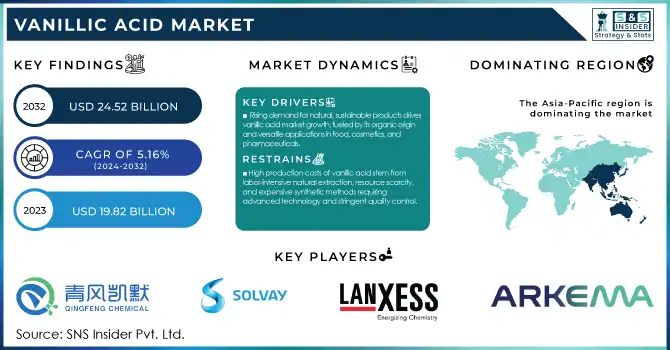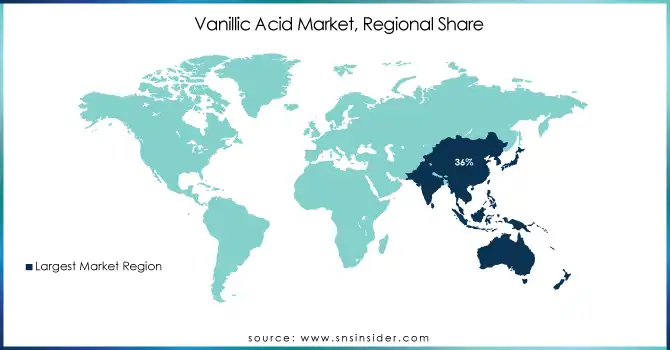Vanillic Acid Market Report Scope & Overview:
The Vanillic Acid Market size was valued at USD 19.82 billion in 2023 and is expected to grow to USD 24.52 billion by 2032 and grow at a CAGR of 2.39% over the forecast period of 2024-2032.

Get E-PDF Sample Report on Vanillic Acid Market - Request Sample Report
Vanillic acid, a naturally occurring compound found in vanilla beans and other plant sources, is gaining prominence across various industries due to its versatile properties. In the food and beverage sector, it serves as a flavoring agent, enhancing the taste of confectioneries, beverages, and baked goods. Its antioxidant, antimicrobial, and anti-inflammatory characteristics make it valuable in pharmaceutical applications, where it's utilized in formulations targeting cardiovascular, diabetic, and neurodegenerative conditions.
The market is witnessing a shift towards natural and organic products, driven by increasing health consciousness among consumers. This trend is propelling the demand for vanillic acid, especially in the flavor and fragrance industries, where it is favored for its natural origin and aromatic properties. Additionally, the cosmetic and personal care sectors are exploring vanillic acid for its potential benefits, aligning with the clean-label movement that emphasizes transparency and natural ingredients.
However, challenges such as limited natural sources and potential supply constraints may impact market dynamics. The extraction of vanillic acid from natural sources like vanilla beans yields relatively low quantities, which could lead to supply shortages and increased prices. Moreover, regulatory considerations regarding purity standards and usage in various applications necessitate compliance, influencing market operations. Despite these challenges, the vanillic acid market is poised for steady growth, supported by ongoing research and development efforts aimed at cost-effective production methods and expanding application scopes. The industry's focus on sustainability and natural product offerings is expected to further drive the adoption of vanillic acid across multiple sectors.
MARKET DYNAMICS
DRIVERS
- The rising demand for natural and sustainable products is driving the growth of the vanillic acid market, as its organic origin and versatile applications cater to evolving consumer preferences across food, cosmetics, and pharmaceuticals.
The rising demand for natural ingredients is significantly influencing the vanillic acid market, as consumers increasingly prioritize health-conscious and sustainable choices. Vanillic acid, derived from natural sources like vanilla beans, aligns with this trend due to its organic origin and versatile properties. In the food and beverage industry, it is widely sought after as a natural flavor enhancer, replacing synthetic alternatives and catering to clean-label product demands. Similarly, its incorporation in cosmetics and personal care products highlights its role in meeting consumer expectations for transparency and eco-friendly formulations. In pharmaceuticals, vanillic acid's antioxidant and antimicrobial properties add further value, making it a preferred component in treatments targeting chronic conditions. As the global inclination toward organic and natural products intensifies, the market for vanillic acid is expected to expand, leveraging its multifaceted applications and ability to align with evolving consumer preferences.
RESTRAINT
- High production costs of vanillic acid stem from labor-intensive natural extraction, resource scarcity, and expensive synthetic methods requiring advanced technology and stringent quality control.
High production costs of vanillic acid arise from the intricate processes involved in its extraction and synthesis. Naturally sourced vanillic acid, primarily derived from vanilla beans, requires labor-intensive harvesting and processing, yielding limited quantities. This scarcity elevates raw material expenses. Additionally, synthetic production methods, while offering a more scalable alternative, involve sophisticated chemical or biological processes that demand advanced technology and expertise. These methods often incur significant operational costs, including energy consumption, specialized equipment, and stringent quality control measures to meet industry standards.
The high costs impact the affordability of vanillic acid, limiting its application in price-sensitive industries such as mass-market food products. Companies may opt for cheaper synthetic substitutes, reducing the competitiveness of vanillic acid. Addressing these cost challenges requires innovation in production techniques, such as fermentation-based methods or engineered biosynthesis, to enhance yield efficiency and reduce expenses without compromising quality.
MARKET SEGMENTATION
By Purity
The Purity 98% segment dominated with the market share over 55% in 2023. This dominance is due to the compound’s versatility and its extensive use across multiple industries, such as food and beverages, pharmaceuticals, and cosmetics. Its affordability and suitable quality make it an ideal choice for a wide range of applications, from flavoring agents to active ingredients in various products. The versatility of Purity 98% vanillic acid allows it to cater to the diverse needs of these industries, reinforcing its position as the market leader in the vanillic acid sector.
By Application
The flavors and fragrance segment dominated with the market share over 52% in 2023. This is largely due to the growing consumer preference for natural and eco-friendly products. Vanillic acid plays a crucial role as an aromatic ingredient in a wide range of fragrances and personal care items, including perfumes, essential oils, aromatic candles, and deodorants. Its pleasant, sweet scent makes it ideal for use in both organic and synthetic fragrance formulations. The increasing demand for skin-friendly, sustainable products further boosts vanillic acid's prominence in the flavors and fragrances sector.
KEY REGIONAL ANALYSIS
The Asia-Pacific region dominated with the market share over 36% in 2023. This dominance is primarily driven by the region's rapid industrialization and its growing demand across multiple sectors, including pharmaceuticals, food and beverages, and cosmetics. Major economies like China and India have experienced significant growth, leading to an increased demand for vanillic acid, a compound valued for its antioxidant properties and its use as a flavoring agent. The pharmaceutical industry relies on vanillic acid for its therapeutic benefits, while the food and beverage sector use it to enhance flavor. Additionally, the cosmetics industry has adopted vanillic acid for its sweet, vanilla-like fragrance and its skin-soothing properties.
Europe is emerging as the fastest-growing region in the vanillic acid market due to its diverse industrial applications. The pharmaceutical sector in Europe is expanding steadily, driving the demand for vanillic acid, which is utilized for its antioxidant and therapeutic properties. This growth is expected to continue over the forecast period, contributing to a higher market share for the region. Additionally, Europe is known for its flourishing fragrance and perfume industry, where vanillic acid plays a key role. Its sweet, vanilla-like scent makes it a valuable ingredient in perfume formulations, enhancing the appeal of fragrances.

Get Customized Report as Per Your Business Requirement - Request For Customized Report
Some of the major key players of the Vanillic Acid Market
- Quzhou Mingfeng Chemical (Vanillic acid, vanillin derivatives)
- Solvay (Aromatic chemicals, flavor ingredients)
- Donglian Nankai FlavorDlflavor (Flavor chemicals, vanillic acid)
- The Good Scents Company (Aroma chemicals, vanillic acid derivatives)
- Parchem Fine & Specialty Chemicals (Specialty chemicals, vanillic acid)
- Otto Chemie Pvt. Ltd. (Vanillic acid, fine chemicals)
- Lanxess (Aromatic chemicals, vanillin derivatives)
- Zhejiang NHU Co., Ltd. (Flavor and fragrance intermediates, vanillic acid)
- Guangzhou Shiny Co., Ltd. (Fine chemicals, vanillic acid)
- Henan Tianfu Chemical Co., Ltd. (Vanillic acid, chemical intermediates)
- Sigma-Aldrich (Merck KGaA) (Research chemicals, vanillic acid)
- TCI Chemicals (Vanillic acid, laboratory reagents)
- Alfa Aesar (Thermo Fisher Scientific) (Research-grade vanillic acid, fine chemicals)
- Beijing Lys Chemicals Co., Ltd. (Aroma chemicals, vanillic acid)
- Arkema (Chemical intermediates, vanillin-related products)
- Fujian Yuanli Active Carbon Co., Ltd. (Vanillin precursors, vanillic acid)
- Jiangxi Global Natural Spice Co., Ltd. (Natural aroma chemicals, vanillic acid)
- Haihang Industry Co., Ltd. (Vanillic acid, fine chemicals)
- Xiamen Hisunny Chemical Co., Ltd. (Chemical intermediates, vanillic acid)
- Cayman Chemical (Biochemical products, vanillic acid)
Suppliers for (high-quality analytical and laboratory chemicals, with a focus on purity and reliable standards) on Vanillic Acid Market
- National Analytical Corporation
- Simson Pharma Limited
- Otto Chemie Pvt. Ltd.
- Vizag Chemical
- Thermo Fisher Scientific
- Chem-Impex International
- Fisher Scientific
- Sigma-Aldrich
- TCI Chemicals
- Loba Chemie Pvt. Ltd.
RECENT DEVELOPMENT
In January 23, 2023: Solvay has launched the first ISCC PLUS certified mass balance vanillin. This innovation helps reduce carbon footprints and supports sustainability in the flavor and fragrance industries.
| Report Attributes | Details |
| Market Size in 2023 | USD 19.82 Billion |
| Market Size by 2032 | USD 24.52 Billion |
| CAGR | CAGR of 2.39% From 2024 to 2032 |
| Base Year | 2023 |
| Forecast Period | 2024-2032 |
| Historical Data | 2020-2022 |
| Report Scope & Coverage | Market Size, Segments Analysis, Competitive Landscape, Regional Analysis, DROC & SWOT Analysis, Forecast Outlook |
| Key Segments | • By Purity (Purity 99%, Purity 98%, and Others) • By Application (Flavors and Fragrances, Pharmaceutical Intermediates, and Others) |
| Regional Analysis/Coverage | North America (US, Canada, Mexico), Europe (Eastern Europe [Poland, Romania, Hungary, Turkey, Rest of Eastern Europe] Western Europe] Germany, France, UK, Italy, Spain, Netherlands, Switzerland, Austria, Rest of Western Europe]), Asia Pacific (China, India, Japan, South Korea, Vietnam, Singapore, Australia, Rest of Asia Pacific), Middle East & Africa (Middle East [UAE, Egypt, Saudi Arabia, Qatar, Rest of Middle East], Africa [Nigeria, South Africa, Rest of Africa], Latin America (Brazil, Argentina, Colombia, Rest of Latin America) |
| Company Profiles | Quzhou Mingfeng Chemical, Solvay, Donglian Nankai FlavorDlflavor, The Good Scents Company, Parchem Fine & Specialty Chemicals, Otto Chemie Pvt. Ltd., Lanxess, Zhejiang NHU Co., Ltd., Guangzhou Shiny Co., Ltd., Henan Tianfu Chemical Co., Ltd., Sigma-Aldrich (Merck KGaA), TCI Chemicals, Alfa Aesar (Thermo Fisher Scientific), Beijing Lys Chemicals Co., Ltd., Arkema, Fujian Yuanli Active Carbon Co., Ltd., Jiangxi Global Natural Spice Co., Ltd., Haihang Industry Co., Ltd., Xiamen Hisunny Chemical Co., Ltd., Cayman Chemical. |
| Key Drivers | • The rising demand for natural and sustainable products is driving the growth of the vanillic acid market, as its organic origin and versatile applications cater to evolving consumer preferences across food, cosmetics, and pharmaceuticals. |
| RESTRAINTS | • High production costs of vanillic acid stem from labor-intensive natural extraction, resource scarcity, and expensive synthetic methods requiring advanced technology and stringent quality control. |

